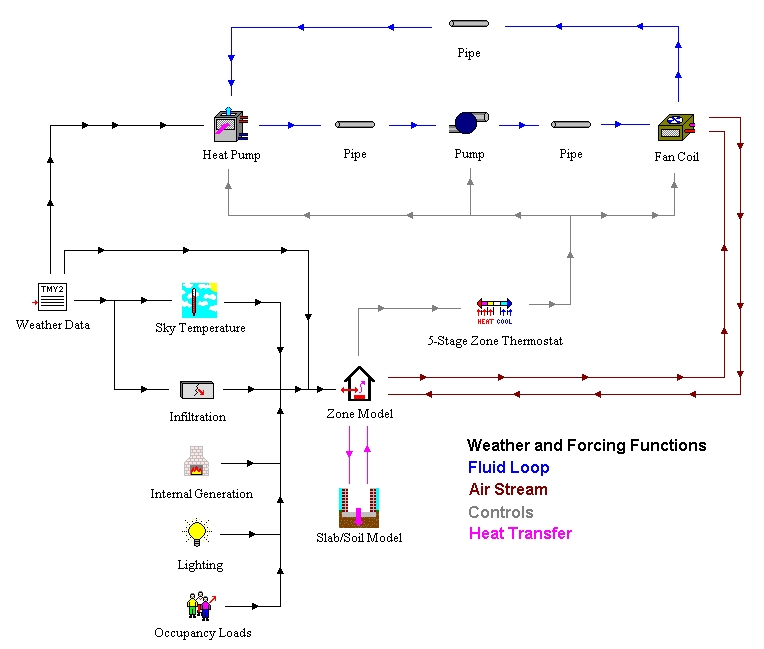[Date Prev][Date Next][Thread Prev][Thread Next][Date Index][Thread Index]
Re: Heat pumps in TRNSYS
- Date: Mon, 22 Mar 2004 14:17:28 -0600
- From: Jeff Thornton <thornton@xxxxxxxxxxxx>
- Subject: Re: Heat pumps in TRNSYS
At 12:16 PM 3/22/2004 +0000, Maurizio Sorce wrote:
for my my
year-long simulation I need to use a air-water heat pump, whose role is
to supply temperature (at 50 and 7°C in winter/summery operation) and
flowrate to the type 673 fan coil. I have Standard TRNSYS and TESS
Libraries but I don't understand which is the type that models the heat
pump.
Maurizio,
As we have discussed, the simple fan coil model you are using is probably
not the best model for your studies. The Type 673 fan coil model
that you are using takes the KNOWN building sensible and latent loads and
imposes them on the fluid flow stream that is passing through the fan
coil unit. This flow stream could then be directed to a heat pump
model to provide the required heating or cooling to the flow
stream. This simplistic approach completely eliminates the dynamic
interaction between the zone, the fan coil, and the heat pump. A
much better approach would be to use a fan coil model that calculates the
air outlet conditions from the fan coil based on the water and air
entering conditions and then directs this air stream to the building
model (which changes the zone temperatures and an iterative process is
commenced). In this way, you get the interaction between the
components that best emulates what happens in real life.
To study the system in this way requires the following steps:
1) Eliminate the simple cooling and heating devices in the zone model
(Type 56) and create ventilation inputs into the zone.
2) Use a fan coil model that takes the inlet air conditions, inlet water
conditions, and fan coil specifics (catalog data, capacities etc.) and
calculates the outlet air and water temperatures and connect this model
to the zone and water stream components. We have such a model that
we will release with version two of the TESS libraries and all of our
models are fully documented. Early versions had the documentation
encased in the IISiBat proforma of the model and latter versions have an
additional technical document (assumptions, algorithms, references etc.)
for users looking for a little more detailed information.
3) Retrieve catalog data for an air-to-water heat pump from the internet,
or a sales rep., that provides the capacity (sens and lat) and power as a
function of the entering water and air conditions. Then you can use
the heat pump models in the TESS libraries that you have purchased (Types
504 and 505 in the current version). These models require files of
performance that you can easily create from the catalog data you just
obtained.
4) Connect the remaining components (thermostat, pump, pipes, ducts etc)
to reflect the system that you are studying and investigate the
system.
I have attached a screen capture of a simple system, similar to what you
have described, modeled in TRNSYS for your reference.
1)
Maybe type 655 can simulate winter operation but I'm searching for a type
that I can use to cool and heat the fluid and not only cool
it.
Type 655 is an air cooled chiller and is not intended for heating
applications.
2) If I use
type 655 I must supply 2 two external data files. The first data file
contains ratios of the capacity to the rated capacity and the COP to the
rated COP as functions of the chilled water set point temperature and the
ambient temperature; the second file must contain the fraction of
full-load power as a function of the part-load ratio on the machine. But
for my heat pump I have only the data presented in the catalogue (ie
rated cooling capacity, rated heating capacity, COP, total fluid flow
rate... see in attachment)!!
There are many companies that provide the information required for the
air cooled chiller model - or you can simply use the default curves
provided in the sample data files that came with your purchase.
With kindest regards,
Jeff Thornton
TESS

